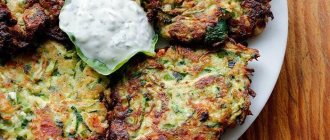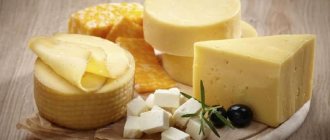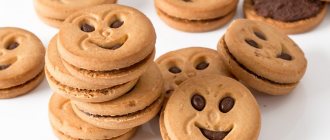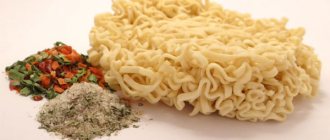During lactation, many women notice increased cravings for sweets. New mothers so want to treat themselves to something tasty, but in order to avoid harm to the newborn baby, they have to give up a lot of their favorite treats. Sweets, cakes, pastries - all this is included in the list of foods prohibited during breastfeeding. Is it possible to include such a well-known and beloved oriental sweet as Turkish Delight in the diet of nursing women during lactation? Let's figure it out.
What are the benefits of Turkish delight?
The Turkish Delight recipe includes the following ingredients:
- sugar;
- starch;
- flour;
- nuts;
- fruits and berries.
The combination of sugar and starch is a source of glucose, which promotes the production of serotonin, which improves mood and helps fight postpartum depression. In small quantities, glucose has a beneficial effect on the body of a woman recovering after the birth of a child - her immunity to viral diseases increases and her skin condition improves.
Nuts are a source of useful substances; they are superior to fruits in terms of microelements. Regular consumption of nuts allows you to:
- improve metabolism;
- remove toxins from the body;
- provide the body with omega-3 fatty acids;
- strengthen the immune system;
- eliminate protein deficiency in the diet and obtain essential amino acids;
- fight depression and loss of strength, relieve nervous tension;
- improve brain function;
- prevent the development of many diseases, including cardiovascular diseases;
- reduce the level of bad cholesterol in the blood.
Each type of nut has its own set of beneficial properties, but all of them are healthy when consumed wisely. Read about what nuts a nursing mother can eat here. Heat treatment practically does not reduce the value of nuts.
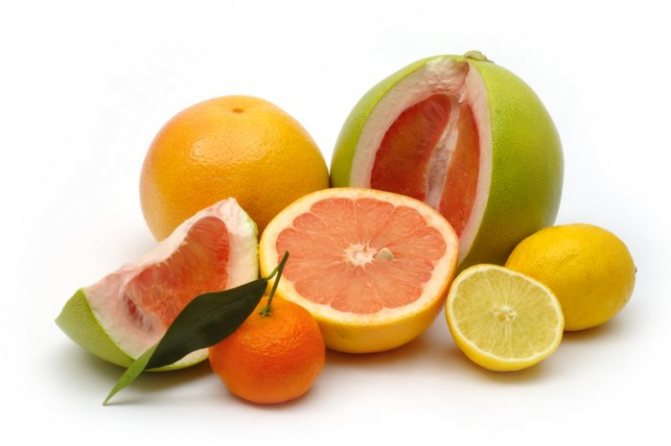
Fruits are a complex of vitamins and minerals. In the preparation of Turkish delight, the pulp of fresh fruits or berries, as well as citrus zest, is used. Pectin and other beneficial substances contained in Turkish delight make the skin elastic and smooth, hair silky, and nails strong.
Choosing a product
There are a huge number of types of Turkish delight, and a nursing mother is advised to choose the safest option. In particular, it is undesirable to consume treats that contain orange or lemon zest, as well as honey - these products are among the strongest allergens.
The base of Turkish delight with nuts is left with sugar mixed with flour and sugar. This is a high-calorie product that cannot be called healthy for a nursing mother. Nuts, rich in fat, also add calories. Abuse of this dish can harm a baby whose stomach is not ready to cope with fatty milk.
A more acceptable option is Turkish delight based on apple or berry puree. The harm from such a delicacy lies only in an excess of glucose. Unlike traditional recipes, the use of gelatin is allowed in modern cooking. This Turkish delight contains less starch, which is required to give the dish its characteristic dense consistency.
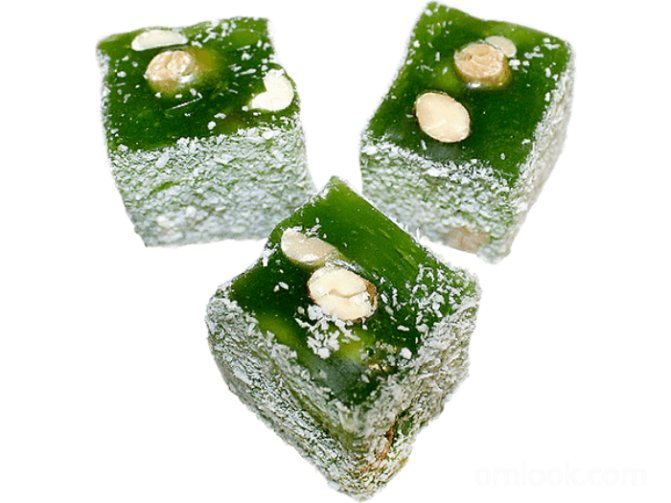
Preference should be given to home-made Turkish delight - only in this case can you be sure that the product does not contain preservatives, flavors and dyes that are added during mass production.
It is important not to overindulge in sweets, as this harms the body of both mother and baby. You can start an experiment on introducing treats into the diet only after you are sure that the child’s digestion is established and he adapts well to new foods.
The breastfeeding diet is very strict and comes with a lot of restrictions, especially regarding sweets. Breastfeeding mothers are wondering if Turkish delight can be eaten while breastfeeding. After all, this sweetness has a wonderful composition and taste. Today we will talk about how to properly introduce the delicacy into the diet, and which Turkish delight is best for a nursing woman to choose.
List of prohibited desserts
All desserts and sweets that can act as a potential allergen should be completely excluded from a nursing mother's diet: products that contain dark or white chocolate, cocoa, coffee. You should be extremely careful with nuts, pomegranates, oranges, tangerines and other citrus fruits. They can often cause not only allergic rashes in the baby, but also colic and increased gas formation in the baby’s tummy.
In addition, a nursing mother must strictly limit the use of:
- cream cakes;
- buns;
- cakes;
- fatty cookies;
- other baked goods;
- chocolates.
If we talk about black, white or milk chocolate, then a young mother can try it only after the baby is 6-8 months old.
The parent should know that it is recommended to start introducing chocolate into the diet with 20-30 g. If the child tolerates such innovations normally and does not experience any deterioration in his health, the amount of chocolate can be increased slightly. But in any case, the amount of chocolate consumed should be strictly limited. Hematogen “presents” the same requirements.
Now let’s look at another question: what to drink with sweets. Unsweetened tea, compotes, and fruit drinks are most suitable for this purpose.
Benefits for nursing mothers and babies
Turkish delight is a tasty and healthy delicacy. The traditional recipe involves the use of flour, sugar, starch, nuts and fruit additives. Since the composition may differ in each case, the properties of Turkish delight also vary. The delicacy is rich in vitamins A, B, C, calcium, iron, potassium and other beneficial substances. Positive properties include the following:
- synthesis of serotonin, which helps cope with depression and stress experienced by new mothers;
- improved mood;
- strengthening the immune system;
- improving the functioning of the cardiovascular system;
- assistance with viral and infectious diseases;
- replenishment of vitamins and minerals that a woman loses during pregnancy, childbirth and breastfeeding;
- improvement of skin and hair condition;
- strengthening the nail plate;
- stimulation of brain function;
- improvement of metabolism;
- replenishment of energy reserves, etc.
How to eat for a nursing mother?
A woman's diet during breastfeeding should first of all be complete and meet the principles of healthy eating. A nursing mother needs to receive proteins, carbohydrates, fats, microelements and vitamins, and fiber. Moreover, we should not forget that the process of milk production requires 500–600 kcal in addition to those that a woman received from food before pregnancy. And everything that is eaten “for two” will settle as fat deposits on the waist and in other “interesting” places.
For comparison, the WHO textbook offers the following set of products as an additional volume to the usual food:
- 60g of rice (carbohydrates) - 240 kcal, which is about a handful;
- 30g beans (protein) - 120 kcal, which is half a handful;
- 1 handful of vegetables (vitamins, microelements, fiber);
- half a banana (vitamins, microelements, fiber, carbohydrates) - 90 kcal;
- 1 tsp vegetable oil (fats) - 50 kcal.
As you can see, milk production requires nothing at all! As for beans and other products, they are given as an example. Some children may become bloated after a nursing mother tries dishes that contain legumes in their recipes. But there are no products in nature that are 100% likely to cause undesirable reactions in all infants without exception.
Each child is individual, and it is not a fact that yours will somehow react negatively to beans, cabbage, cucumbers or anything else.
In fact, a nursing mother should not starve. This will have little effect on the volume and usefulness of milk. But due to the stress in which the body is in the process of fasting and refusing “goodies,” the production of the hormone oxytocin decreases. And oxytocin is responsible for the secretion of milk from the mammary glands. The less oxytocin, the more difficult it is for the child to receive the treasured mother's milk. So recipes for breastfeeding dishes should be tasty and healthy, delivering gastronomic pleasure to the nursing mother and not harming the baby.
Can a nursing mother eat Turkish delight?
Real Turkish delight is very good for health, so you shouldn’t give it up for the entire period of breastfeeding, which cannot be said about most store-bought varieties, saturated with flavors, dyes and other chemical additives. Since the product is multi-component and may contain allergens, it is important to correctly introduce it into the diet and eat it during breastfeeding. This way you can get the maximum benefit and not harm the baby.

When breastfeeding, choose Turkish delight without additives, colors or flavors.
The diet of a lactating woman in the first months of breastfeeding should be as safe as possible for the baby, since his body is just learning to adapt to environmental conditions. The gastrointestinal tract adapts to the new type of nutrition, digesting new components. During this period, it is forbidden to eat allergens and foods that are difficult to digest. That is why such a healthy sweet as Turkish delight should not be included in the menu of a nursing mother immediately after childbirth.
Acquaintance with Turkish delight should begin no earlier than 3 months after birth. For the first time, choose a product with the most hypoallergenic composition, that is, without citrus fruits, raspberries, peanuts and other strong allergens. It is best if the sweet ingredients are already present in your menu. This will reduce the risk of an allergic reaction in a breastfed baby.
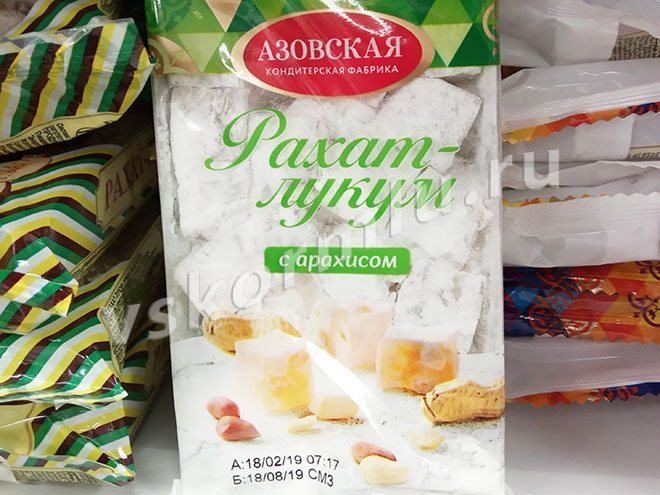
Turkish delight with peanuts should not be tried during breastfeeding due to the increased risk of allergies.
Conduct the first tasting in the morning. Start with a small piece. Wash down the treat with weak tea or water. An allergic reaction or digestive problems in an infant most often manifests itself within 1–2 days after the test. Since Turkish delight consists of a large number of components, you should observe your child for about a week. If everything went well, you can gradually increase the amount of sweets in your diet. You should not eat it every day. The maximum daily dose is 50 g.
Recommendations
Since radish can not only affect the functioning of the baby’s intestines, but also provoke allergic reactions, you should follow the tips below:
- It is not recommended to introduce it into the diet in the first 2 months after birth (if the baby does not have tummy problems or regular diathesis). This period is doubled if they are available;
- at the first tasting, you should squeeze out a small amount of radish juice (10-15 drops), dilute them with water and drink in the first half of the day, not on an empty stomach;
- if within 2 days the baby has no negative or undesirable reactions, you can gradually increase the portions of radish in the diet of the nursing mother;
- It is noteworthy that you can start eating the fruit itself after 3-4 doses of its juice and water. When tasting radish for the first time, it is recommended to eat 1/2 of the vegetable, and if the baby reacts favorably to it, gradually increase the amount;
- It is not recommended to eat more than 5 fruits per day, and 15 pcs. in Week. The most acceptable frequency of consuming radish is 1 time per week at the beginning of the season, and 2 times at the end.
You should also be aware of the ability of radish to affect the taste of breast milk, so you should avoid eating fruits that are too bitter. To eliminate bitterness, it is recommended to peel it, cut it into slices and soak for 30-60 minutes. in cool, slightly salted water. You can also lightly sprinkle it with lemon juice, but only if the baby does not have allergic reactions to it.
How to choose a useful product?
There are many types of Turkish delight. During breastfeeding, it is especially important to choose the most useful and safe one. When choosing a treat, first of all pay attention to the composition. The basis of the sweetness is flour with sugar and nuts. Their presence in real Turkish delight is mandatory.
Pay attention to the fruit component. The presence of lemon or orange zest, juice of allergenic fruits and berries is undesirable. Such components can be present in the diet of a breastfed woman for closer to six months. May contain honey. Remember that it is an allergen, so products containing it must be introduced into the diet with particular caution.
If you're looking for sweet treats you can eat while breastfeeding, check out Turkish Delight, which is made with berries or applesauce. The presence of gelatin was not recommended in the original formulation, but is allowed and is often used today. This reduces the amount of starch as a thickener.
What sweets can you eat while breastfeeding?
- Oriental sweets (Turkish delight, kozinaki): help improve the functioning of the circulatory system, the condition of blood vessels, hair, and nails. Relieves fatigue and energizes. But it is worth remembering that the nuts and seeds that make up these treats are allergens. When consuming these sweets, carefully monitor your baby’s reaction.
- Marmalade: healthy and practically safe, provided there are no harmful additives or dyes. And you can find such a product in stores. But you can always make marmalade with a guaranteed natural composition at home from fruits and gelatin.
- Cookie. The safest and healthiest are oatmeal, rye, biscuits, as well as special children's cookies that are on sale. It's best to make your own cookies at home.
- Rusks, drying. You should choose the most common ones, without additives or “special” tastes. It is not recommended to use these products if the mother or baby has constipation.
- Marshmallow. Pay attention to the composition and give preference to a natural product. It is best to choose white marshmallows, without icing. A tasty and healthy option is to make it at home from applesauce.
- Paste. It is based on fruit and berry puree, so a nursing mother can include this delicacy in her diet. But again, study the composition of the product and monitor the baby.
- Meringue. A tasty and safe sweet if the child is not allergic to eggs.
- Jelly, jam: are natural products, especially if prepared at home.
- Iris.
- Caramel without dyes, exotic or coffee fillings. Caramel familiar from childhood (for example, “Rachki”) is best suited.
Photo gallery: preferred products
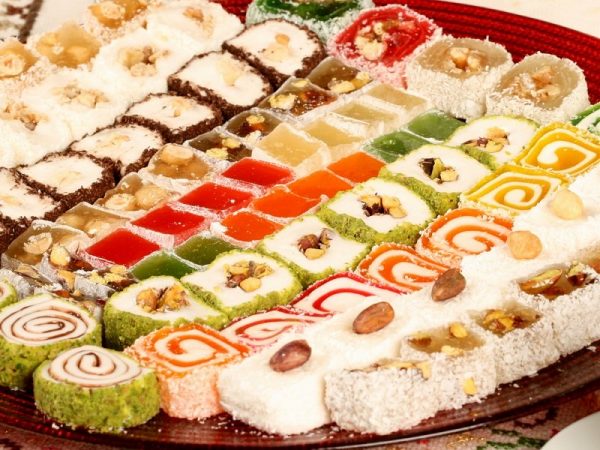
Oriental sweets have a good effect on the functioning of the circulatory system, but if they contain a high content of nuts, you should be careful

Marmalade containing only natural ingredients is safe for nursing mothers
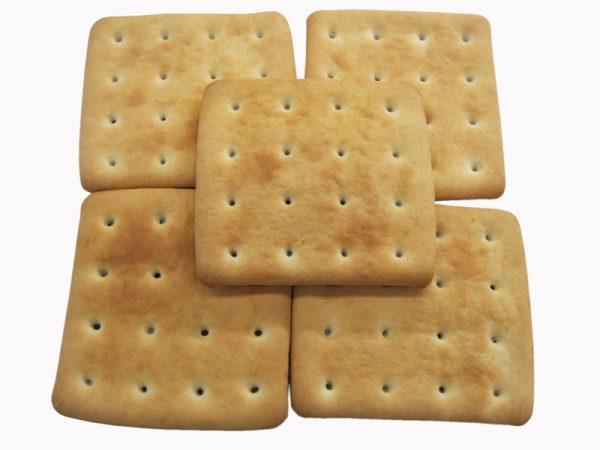
Biscuit-type cookies contain almost no sugar, which makes them a safe product for breastfeeding
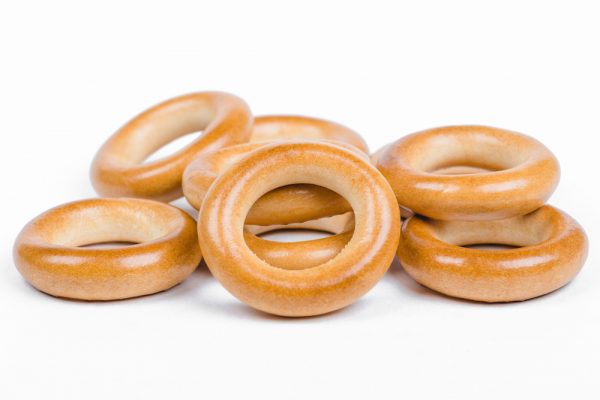
Basically, drying products are suitable for a nursing mother, but they should be used with caution if she or the baby has constipation
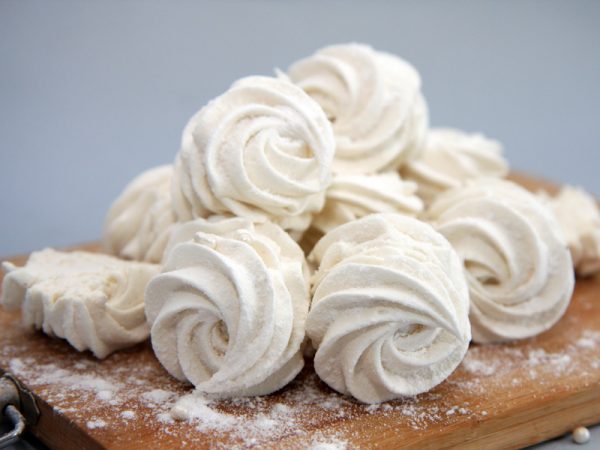
Marshmallows with a minimal amount of additives will be a good addition to the menu of a nursing mother.
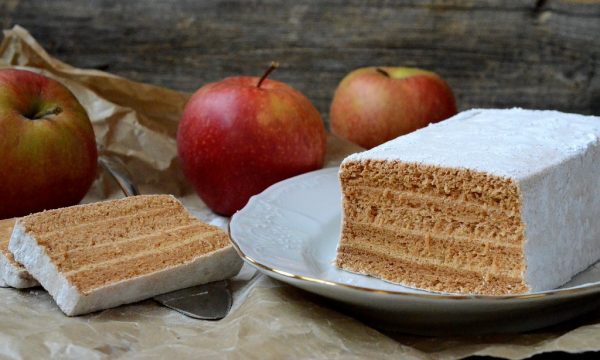
Fruit puree included in the marshmallow must contain only natural ingredients

Light meringue is suitable for a nursing mother only if she or her child has no allergic reactions to eggs

A nursing mother should give preference to homemade jelly

Jam will be healthier if it is made at home
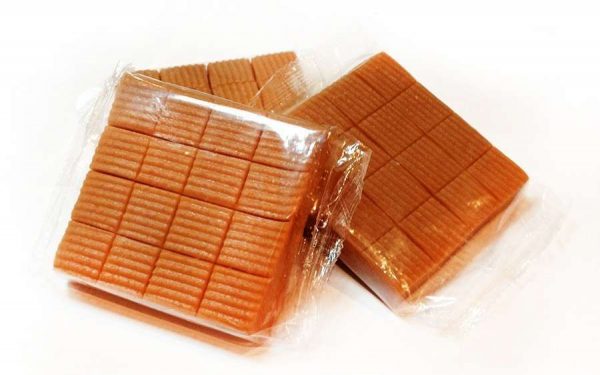
Iris should not contain any dyes.

For a nursing mother, caramel without dyes and exotic fillings is best suited
Reviews
Victoria, 24 years old
I really love Turkish delight. But ours is not tasty at all. Anyone who has tried real Turkish will confirm. During breastfeeding, I ate imported food. All my friends brought it to me from vacation)) It didn’t rain on him, the baby had no problems with bowel movements. Great.
I constantly ate store-bought Turkish delight from 2 or 3 months of breastfeeding. Never had a small one spill out. And colic didn’t bother us. I really fell in love with this sweetness during this period. Pastila and marmalade are not the same at all.
I read on the Internet that it is useful to eat Turkish delight during breastfeeding. I went and bought it. Well, in general, we were on antihistamines for a month. The rash was terrible; spots appeared on the child right before his eyes. I didn't eat anymore.
The health of the baby largely depends on how a woman eats during breastfeeding (especially in the first months after childbirth). Some products are extremely beneficial, while others should be avoided altogether.
What types of confectionery products are the safest for a fragile child’s body? When and how to introduce them into the diet and can they be given to a child?
What confectionery products are possible during breastfeeding?
Of course, you can eat sweet foods during breastfeeding (but only occasionally and in small quantities). However, not all of them are equally safe. Most of them are stuffed with flavorings, preservatives and dyes, so it is better to avoid using them (since the child may have allergic reactions and a general deterioration in well-being).
Based on the results of studies of the composition of confectionery products and observations of the reaction of newborns to them, pediatricians recommend introducing sweets into the diet starting from 3 or 6 months after birth (depending on a particular product).
Is it possible to have Turkish delight, meringues, waffles and other sweets? For each product, experts recommend adhering to the following recommendations (when introduced into the diet):
- Corn sticks are high in calories and contain not very healthy additives (chemical sweeteners, flavorings, etc.), so they can serve as a source of allergies and digestive disorders in a child. However, if they are not abused, there will not be much harm. You can introduce corn sticks into your diet 3 months after birth.
- Waffles are a nutritious, high-calorie product that can lead to diathesis in a baby (because it contains cocoa, emulsifiers, preservatives, etc.). It is recommended to introduce waffles into the diet at 5-6 months of breastfeeding (if the child does not have allergies, it can be done from 3 months). The optimal daily intake is 1-2 pieces, but it is highly undesirable to use them every day.
- Cake - it is advisable to avoid fatty store-bought cakes altogether (during the entire period of breastfeeding).
But homemade confectionery products, which contain a minimum of ingredients (curd or yogurt-based), are allowed to be introduced into the diet for 3-4 months.
- Condensed milk - no matter what kind of condensed milk is used - raw or boiled, it is highly not recommended to use it in the first month after childbirth, since it can cause allergies, constipation, bloating, etc. in the child. Therefore, condensed milk can be introduced into the diet only after 3 months of breastfeeding (and no more than 2 tablespoons per day).
- Ice cream - this high-calorie and nutritious product (due to the milk and sugar content) can be introduced into the diet a month (or preferably three) after childbirth. At the same time, it is not recommended to consume fruit ice cream, as well as with chocolate and various fillings (jam, marmalade, caramel, etc.). Preference should be given to simple creamy ice cream (preferably homemade).
- Halva - in order to avoid an allergic reaction in the baby, consuming this oriental dessert in the first month after childbirth is strictly prohibited (but in the second month of breastfeeding it is already possible). The recommended daily intake is one small piece with tea (in the morning).
- Pastila is a natural product based on sugar and fruit puree, which is not only safe, but also healthy.
However, despite this, pediatricians advise introducing it into the diet only in the 2nd month after birth. The daily intake of this delicacy is 50 grams (2-3 times a week).Gingerbread - thanks to the increased content of sugar, molasses and honey, this delicacy improves mental activity.
Harm from sweets
Answering the question: can nursing mothers have sweets, we note that it all depends on what kind of food products sweets are: healthy or harmful. It is not recommended to include in the menu products that contain a predominance of refined sugar.
It is of no benefit to the body and contributes to the intensive accumulation of extra pounds.
Let's consider what harm is attributed to sweets during breastfeeding:
- The abundance of sweets and carbohydrates during breastfeeding puts a huge burden on the fragile child's body, which can be expressed in painful cramps, colic, and bloating in the baby.
- Many sweets sold in stores contain synthetic dyes, preservatives, and flavorings that can cause serious allergic reactions in a child.
- Some sweets consumed by a nursing mother cause food poisoning in the newborn.
Too frequent consumption of sweets and desserts has a negative effect on the body of a nursing mother. This increases the likelihood of developing diabetes mellitus, puts intense strain on the functioning of the pancreas, and leads to the appearance of unattractive folds in the waist area.
Mothers ask if a nursing mother can have sweets immediately after the baby is born. Many experts are sure that during the first month it is best for a young mother to give up her favorite sweets.
The first allowed dessert is best eaten only 2-3 months after giving birth. At this time, the baby’s body is already quite strong: it independently copes with carbohydrates entering the child’s body with breast milk.
Can they be included in a child’s diet?
It is recommended to gradually introduce sweets into your baby’s diet, but not all of them are equally healthy and safe. So, homemade or more or less natural products (halva, Lenten cookies, low-fat ice cream, marshmallows, marmalade, etc.) will be preferable. However, they should be given after the main meal and in strictly limited quantities.
Starting from 1-1.5 years old, a child can be gradually introduced to such treats as marshmallows and marmalade (small pieces at a time). And in the absence of allergies, gradually increase the portions. Somewhat later (at 2.5-3 years), it is allowed to give low-fat ice cream (preferably made at home).
Cookie
Can a nursing mother have sweets in the form of cookies? Let's start with the fact that this is a flour product, which includes flour, sugar and various additives. They are not good for your or your child's health.
Try to keep flour in your diet to a minimum.
If you are used to drinking tea with cookies after meals (like me :-)), then focus on oatmeal cookies.
It satisfies hunger and saturates the body with energy. It’s not bad if you decide to cook it at home. In this case, you can add apples and dried fruits to the dough to make the baked goods much tastier, and, most importantly, healthier.
An alternative to oatmeal cookies can be rye, you can buy biscuits or simple bagels.
Yes, it’s not very tasty, but it will solve problems with excess weight after childbirth, and you will avoid worries about allergies.
By the way, I recommend watching the seminar of the same name for a more complete acquaintance with the topic of nutrition for a nursing mother. This is more than 3 hours of practical knowledge that will save your nerves and you will stop worrying about the foods you eat.
Benefits and harms
The beneficial properties of sweet foods include:
The harm is that store-bought sweets, as a rule, contain many artificial components (chemical flavors, dyes, sweeteners, thickeners, etc.), which provoke allergic reactions (skin rash, redness, itching).
Another danger is the following: most products such as cakes, cookies, condensed milk, ice cream, etc. have high fat content, which contributes to increased gas formation, as well as the appearance of intestinal colic and constipation in a child. In addition, with excessive consumption of sweets, mother and child may experience an increase in body weight.
Recommendations for use
During lactation, mothers must adhere to the following recommendations:
Any product should be introduced into the diet gradually.
Any sweet product must be introduced into the diet gradually (in small portions). Then, over the course of several days, you need to observe the response of the child’s body and, in the absence of allergies and problems with the gastrointestinal tract, you can gradually increase the dosage.
If during lactation you really want some sweets, but you can’t, you can make the following compromise: eat the product in small quantities (for example, a piece of halva or chocolate), and then not take risks and wait the necessary time. This will make food as safe as possible, without giving cause for concern.
Video on the topic
Next, you can watch a useful video about the various nuances of eating sweets during breastfeeding:
Everyone knows that many women love sweets and a variety of pastries. Such an addiction can be dangerous for their figure; women reproach themselves for eating improperly, but do not know that their tastes are scientifically based. Why do women love sweets and starchy foods so much? They spend a lot of energy, so they need carbohydrates, while men cannot do without the proteins contained in meat.
Breastfeeding mothers also crave sweets. Some people will be satisfied with just tea, while others will want to add cake to it. The desire to eat something sweet while breastfeeding is quite natural: breastfeeding requires a lot of energy. Anxiety, worry about the child’s health, and the inability to get a good night’s sleep also deplete one’s strength and require replenishment of expended energy. Sweets are natural antidepressants and, in addition, an excellent source of energy.
What else is prepared from natural products?
Other desserts that are suitable for a young mother:
- Meringue (meringue). The delicacy is made from egg whites and sugar, so moderate consumption of meringue will not cause harm if eggs are not contraindicated for the baby.
- Cranberries in sugar. It can be consumed without fear; it is not only tasty, but also healthy.
- Almonds in sugar. Also very tasty and healthy. In addition, almonds cause an allergic reaction less often than other types of nuts (for more details, see the article: Can a nursing mother eat almonds?).
- Jam . Homemade jam does not contain harmful preservatives, and is also very tasty. Bread with jam is a cake that will bring pleasure and will not harm your health.
- Children's cookies. These cookies are prepared specifically for feeding children; they cannot harm the baby, so you can safely eat them. It is also suitable for making cakes, but you should not use instant varieties for this purpose. A simple recipe: prepare the cream by whipping sour cream and sugar, put the cookies on a plate, brush with cream, cover with another cookie, brush again. 2-3 layers is quite enough. Now you need to put all this in the refrigerator for an hour, and the cake is ready. Mom can also have oatmeal cookies, but they are not suitable for cakes (we recommend reading: Can mothers eat oatmeal cookies while breastfeeding?).
- Home cake . Also a great option for a nursing mother, you just need to choose the right filling. The cakes can be greased with the cream described above or with homemade jam. When using store-bought products, you should completely avoid those that contain flavorings, preservatives and dyes. You should also not use chocolate, cocoa, baking powder or emulsifiers.
- Lokum. It is made from sugar, flour and nuts; in some types, fruit juice, rose petals, and figs are added (more details in the article: can a nursing mother eat figs during breastfeeding?). When adding Turkish delight to your menu, you need to monitor your baby’s reaction. Nuts are a strong allergen, so you shouldn’t eat a lot of Turkish delight at once. For such cases, there is white Turkish delight that does not contain nuts.
Vegetable dishes for nursing mothers, recipes
In general, there are plenty of vegetable dishes for women who are breastfeeding to diversify your menu and not get bored.
Vegetable soup
- water - 2.5 l;
- buckwheat - 1 glass;
- potatoes - 3 pcs.;
- greens, salt - to taste;
- onions – ½ pcs.;
- carrots - 1 pc.;
- bay leaf - 3 pcs.;
- sunflower oil - 30 ml.
Add diced potatoes and carrots to boiling water. Sauté the onion in oil and 15 minutes after the vegetables boil, add it and the washed buckwheat to the soup. When the water boils, you need to cook the soup for another 10 minutes. Then add bay leaf and salt. You can add greens to improve the taste.
Zucchini casserole with cheese
- 2–3 zucchini;
- 2 eggs;
- 300 ml milk;
- 200 g cheese;
- salt to taste.
Cut the zucchini into rings. Place in the pan in layers: a layer of zucchini, a layer of cheese, then another layer of zucchini. Pour in a mixture of eggs, milk and salt. Sprinkle cheese again on top. Place in an oven preheated to 180 degrees for 35 minutes. After the cheese turns golden brown, cover the pan with foil.
Cauliflower salad
- 400 g cauliflower;
- 150 ml low-fat sour cream;
- a small handful of walnuts;
- salt to taste.
Boil the cauliflower until tender. Pour it with sauce made from sour cream, chopped walnuts and salt. You can add dill.
Beet salad
- 1 large beet;
- 150 ml low-fat sour cream;
- 2 prunes;
- a handful of walnuts;
- salt to taste.
Boil the beets until tender. Grind on a grater or in a blender. Mix beets with chopped prunes, walnuts and sour cream. Add salt to taste.
Vegetable stew in a slow cooker
It is better to cook vegetable stew in a slow cooker. Since vegetables are cooked there at lower temperatures, more vitamins remain during cooking. Also, when cooking, you can not use oil at all or use a minimal amount of it.
- 3 pcs. potatoes;
- 1 zucchini or zucchini;
- 1 squash;
- 1 carrot;
- 1 onion;
- 2–3 tomatoes;
- salt to taste.
Peel the vegetables, wash and dry. Cut the onion into cubes, grate the carrots. Cut the remaining vegetables into cubes. Add everything to the multicooker bowl. Pour a little water, salt to taste, stir and set the “stew” mode for an hour. You can add greens to the finished dish.
Use of sweeteners
It must be remembered that breastfeeding women should not consume:
- xylitol;
- sorbitol;
- aspartame and other synthetic products.
Sweeteners that get into mother's milk, and from there into the baby's body, will not be processed; the baby does not yet have the means for this. Some of the substitutes, for example, aspartame, when digested, turn into methyl alcohol, which is a powerful poison. The synthetic substitute cyclamate is completely banned in the European Union. One of the oldest substitutes, saccharin, has a destructive effect on the gastrointestinal tract, so it is as harmful to the mother as it is to the child.
Let's sum it up
Breastfeeding involves eating sweets, since a large amount of glucose is released with milk, and milk production itself is energy-consuming. A lack of carbohydrates can lead to irritability, headaches, and fatigue. In order not to aggravate natural fatigue, and not to bring yourself to an aggressive state, which has such a harmful effect on family life, you should not deny yourself sweet treats. Their moderate consumption will help not only maintain strength and health, but also get pleasure. You can prepare sweets at home - there are many recipes, some of them can be watched on video.
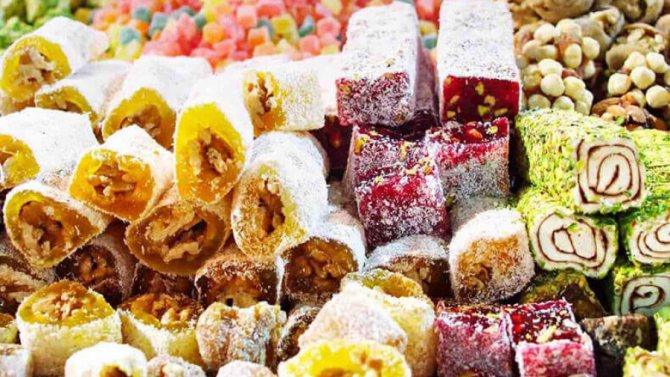
What kind of Turkish delight is possible for breastfeeding?
You can often see fruit Turkish delight in stores. It is better not to eat this type while breastfeeding, since such sweets contain many dyes and flavors. In addition, citrus and fruit juice that enter the child’s body along with milk can cause allergies. Oriental delicacies with honey can also cause allergic reactions (see Honey for breastfeeding).
If we talk about the classic version of Turkish delight, then it won’t hurt. To make sure that the product is of high quality, it is better to make it at home rather than buy it in stores. You should start consuming it sparingly at the beginning of the day, and be sure to monitor whether your baby has an allergy.
Can a nursing mother have Turkish delight? The answer is obvious - you can, if it is natural, fresh and without dyes! Don't deny yourself sweets, eat healthy for yourself and your child's development.
Specialist in breastfeeding and feeding children up to one year. Consulting on vaccinations, feeding, assessment of the child’s physical and neuropsychic development.
This site uses Akismet to reduce spam. Find out how your comment data is processed.
Allowed desserts during breastfeeding
So, let's look at what sweets a nursing mother can eat. There is a list of products that are considered completely safe for consumption by both nursing mothers and newborns.
- Marshmallow. Approved product for all periods of breastfeeding. Of course, in this case we are talking only about natural marshmallows, preferably vanilla or homemade. You should not buy treats that are pink, yellow or other bright colors - this is the result of food dyes and synthetic substances.
- Kozinaki, halva. They can be eaten during lactation, provided there is no allergy to the seeds. The maximum permissible daily dose should not exceed 100 g.
- Candies: caramel, toffee “Korovka”, jelly sweets. You should not eat sweets that contain chocolate or cocoa.
- Jam. Great for tea; it is best to opt for homemade jams and preserves.
- Marmalade is one of the allowed desserts; it should not contain harmful dyes or flavors.
The question is, what else can a nursing woman do? You are allowed to pamper yourself with fruit and berry marshmallows, cookies, crackers, and raisin crackers. Candied fruits and dried fruits are also not prohibited.
A frequently asked question: is it okay to eat cake while breastfeeding? It should be noted that cakes are allowed during breastfeeding, but it is best to choose low-fat baked goods, such as cheesecake or sponge cake. Oatmeal cookies or baked goods such as biscuits or cookies intended for baby food are perfect.
When the baby is 2-3 months old, a nursing woman can treat herself to ice cream or condensed milk if the baby is not lactose intolerant.
When choosing ice cream, you should not choose products with coffee, chocolate or fruit fillings. As a rule, they contain a huge amount of preservatives and dyes.
You should also be extremely careful with condensed milk, as it contains a large amount of sugar. It is best for mothers during lactation to pamper themselves with desserts and pastries prepared with their own hands. Various cheesecakes with fruits and dried fruits, sour cream and curd cakes, meringues, low-fat cookies will perfectly decorate any tea party and bring a lot of pleasure.
